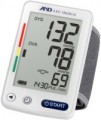Pressure measuring range
The effective measurement range of a blood pressure monitor covers both "upper" and "lower" pressure values. Most modern devices have a lower limit within 0-20 mm Hg, which is adequate for the majority of cases. As for the upper limit, a device with a maximum value of 180 mm Hg is generally sufficient for individuals without a history of significant blood pressure spikes until old age or without serious illnesses. However, for those prone to substantial increases, it's advisable to consider devices with higher upper limit values, which can reach up to 280 mm Hg in modern blood pressure monitors.
Pulse measurement range
The blood pressure monitor's pulse rate measurement capability typically falls within a range of 30-40 to 180 beats per minute. While extending the lower limit is unnecessary for household blood pressure monitors, a higher upper limit may be essential for measurements during intense physical activity or for individuals with conditions causing significant heart rate acceleration, such as tachycardia.
Cuff dimensions
The cuff's applicable range includes both the minimum and
maximum circumferences of the upper arm or wrist (see "Place of measurement"). Modern blood pressure monitors typically feature cuffs suitable for individuals with average physique, covering the majority of adult patients. However, for specialized cases, such as monitoring a child or someone with a larger bicep circumference, it is advisable to measure the arm circumference and compare it with the specified cuff sizes.
—
Small. The small cuffs are designed for a shoulder girth of 17-22 cm.
—
Standard. Standard cuffs cover a shoulder girth of 22-32 cm.
—
Oversized. Oversized cuffs have a girth of 22-36 cm.
—
Universal. Cuffs for both thin and large people. Universal cuffs provide a shoulder girth of 22-42 cm.
—
Large. Large cuffs with a girth of 33-46 cm are suitable for a full arm or a muscular shoulder of a conditional bodybuilder.

